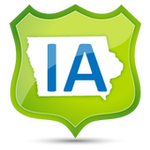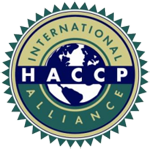Iowa Food Safety State Requirements
 Iowa requires that a food handler and a person in charge, an owner, manager or employee of a food establishment (i.e., restaurants, markets, bakeries, bars, food trucks, commissaries, and food facilities that prepare, handle, or serve non-prepackaged potentially hazardous food) demonstrate knowledge of food safety as outlined in the FDA Food Code by successfully passing an approved food safety training course, and if needed, become a certified food manager, take an accredited ANSI-CFP 8-hour food safety certification course, and pass an examination.
Iowa requires that a food handler and a person in charge, an owner, manager or employee of a food establishment (i.e., restaurants, markets, bakeries, bars, food trucks, commissaries, and food facilities that prepare, handle, or serve non-prepackaged potentially hazardous food) demonstrate knowledge of food safety as outlined in the FDA Food Code by successfully passing an approved food safety training course, and if needed, become a certified food manager, take an accredited ANSI-CFP 8-hour food safety certification course, and pass an examination.
Food Handlers are required to take a short 2 hour training course and pass an exam. To become a Certified Food Manager, taking an approved Certified Food Protection Manager (CFPM) Training Course and passing an exam is necessary. The Learn2Serve Food Protection Manager Certification is approved by the American National Standards Institute and the Conference for Food Protection (ANSI-CFP). This accredited exam is accepted in all states that have mandatory certification requirements for Food Management Professionals. Local requirements may exceed the state’s minimum requirements.
Remember, schedule your certification exam with PSI Exams online for a computer testing center near you. (Note: To login to the exam, you will need the username and password sent to you in an enrollment notice email after purchase.) Click here to view the PSI Examination Tutorial.
Iowa Food Safety Regulations
Iowa Administrative Code Chapter 481-30. Food and Consumer Safety (PDF)
URL: https://www.legis.iowa.gov/docs/iac/chapter/481.30.pdf
Iowa Food and Consumer Safety: https://dia.iowa.gov/food-consumer-safety
Iowa Food Safety License and Applications: https://dia.iowa.gov/food-consumer-safety/food-safety-license-applications
Iowa Food Safety Training Requirements & Re-Certification
Food Safety Training Required For Managers: Yes
Food Safety Training Required Food Handlers: Yes
Food Manager Certification Exam Required: Yes
Re-Training Frequency: Every 5 years
Re-Certification Exam: Every 5 years
Iowa Food Safety State Contact(s)
Iowa Department of Inspections
Lucas State Office Building
321 East 12th Street
Des Moines, Iowa 50319-0083
Phone: (515) 281-7102
URL: https://dia.iowa.gov/food-consumer-safety
Des Moines, Soiux City, Cedar Rapids, Dubuque, Davenport, Mason City, Iowa City, Waterloo.
Iowa Food Safety Local Requirements
Local Requirements: N/A
ANSI Certified Food Handler Course
Course Description
Most people working in restaurants, on a mobile food truck, caterers, and non-restaurant facilities need food safety training or a food handlers card. To get that card, food handling and serving personnel should complete food handling training. After completing the course, they have to present the food handlers certificate to their local authority and pay the required registration fees.
Food Handler Training is often intended for entry-level professionals in the food service industry, such as servers, chefs, cooks, cashiers, food truck workers, mobile food vendors, caterers, and even convenient store (c-store) clerks. The Food Handler Certificate will require the learner to complete a brief 2-hour training course covering basic food safety principles. At the conclusion of the course, the learner will be tested on their knowledge of the content and learning outcomes. Upon successfully passing the exam, the learner will be issued a Food Handler’s Certificate document (or card).
The Learn2Serve.com ANSI Certified Food Handler course will discuss various food safety issues, regulations, and techniques to maintain a food-safe environment. It will help you to better understand how handling food correctly is not only the law, but it improves safety and reduces risks.
Credit Hours: 2 hrs
Cost: $7.00
Course Outline
At the conclusion of the ANSI Certified Food Handler Certificate program, you should be able to:
- Identify biological, physical, and chemical contamination.
- Identify foodborne illnesses, signs of food spoilage, types of food prep contamination, and proper temperature control methods.
- Safely store and prepare meat, poultry, and vegetables.
- Demonstrate effective food handling techniques that promote cleanliness and safety in food establishments.
- Discuss the importance of proper personal hygiene in the workplace.
- Implement appropriate procedures to receive and store food.
- Summarize practices for properly cleaning and sanitizing food contact materials and surface.
Upon successful completion of the course and the exam, you will earn your food handler certificate of completion from your training page.
Food Safety Manager Course & ANSI-CFP Certification Exam
Food Manager Training Course
The Food Safety Manager Principles Course provides a foundational knowledge of the FDA Food Code and covers foodborne hazards and pathogens, cross contamination, proper preparation and temperature controls, proper hygiene, proper cleaning and sanitation methods, regulations, and the proper techniques to maintain a food-safe environment.
Audience: Experienced professionals in the food service industry, such as owner, manager, person-in-charge (PIC), chef, cook, or any employee.
Course Outline
- Lesson 1: Introduction to Food Safety
- Lesson 2: Biohazards, Foodborne Disease, and Food Spoilage
- Lesson 3: Contaminants
- Lesson 4: Food and Temperature Control
- Lesson 5: Employee Health, Hygiene, and Training
- Lesson 6: Purchasing, Receiving, and Storing Food
- Lesson 7: Cleaning and Sanitizing
- Lesson 8: Pest Control
- Lesson 9: Facility Design
- Lesson 10: HACCP System Basics
- Lesson 11: FDA Guidelines for Developing a HACCP System
- Lesson 12: Developing, Implementing, and Maintaining a HACCP Plan
- Lesson 13: Seafood HACCP
- Lesson 14: Consumer Steps to Safer Seafood
ANSI Certification Exam
To be certified as a food manager, the individual must pass an accredited food safety examination - administered by a certification provider.
The Learn2Serve Food Protection Manager Certification is approved by the American National Standards Institute and the Conference for Food Protection (ANSI-CFP). With the exception of Connecticut, this accredited exam is accepted in all states/jurisdictions that have mandatory certification requirements for Food Management Professionals.
Reference: ANSI (American National Standards Institute)
Help with Exam
We have partnered with PSI - a global testing, certification, and licensing provider. The exam is proctored at a PSI test center location.
After purchasing the exam, you should receive an email from PSI instructing you how to schedule your exam. If you do not receive this email, please contact support at 877.881.2235.
You can also click here to schedule exam online at a testing center near you.
Upon successful completion of the exam with a passing score, you may download and print a proof of completion document. The official certificate will be mailed within 15 business days of completing the exam.
Frequently Asked Questions
Your employer might ask you to take a ServSafe course to be food safety training qualified. This is simply a food safety training course brand name.
Our Learn2Serve food safety training courses are the same thing as ServSafe and our Certified Food Manager Exam is ANSI-CFP approved and approved for all states.
Accreditation Reference
American National Standards Institute and the Conference for Food Protection (ANSI-CFP) Accreditation Program
Food Protection Manager Certification Program
Company: 360training.com, Inc.
Accreditation ID: 0975
Website: ANSI (American National Standards Institute)
- Player is “stuck”?
- Error message on page?
- Page not displaying correctly?
All three of these issues can usually be fixed by clearing your cache or cookies. Here is a site we recommend http://www.wikihow.com/Clear-Your-Browser's-Cache you can also do an internet search for “clearing cache” as there are many online resources to assist you in accomplishing this.
When you have completed your course and closed the player window, please go back to the My Courses page and refresh the screen. The Print Certificate link will show in blue text underneath the course name. If you don't see it, you must refresh your browser using its "Refresh" located near the top of your screen.
If you need proof of your certification immediately, please login to your account using the username and password that you originally used to take the course. If you forgot your username and password, please call 1-877-881-2235 to have one of our service representatives look it up for you. Then choose “resume course in progress” and it will forward you to the end of the course. You will then have an option to print your certificate.
Also, please call Customer Service at 1-877-881-2235 to request another copy of your certificate to be mailed to you. Official certificates will take approximately 7-10 business days to be mailed.
If you have a MAC you can still sign on to take any of our classes. Many of our customers have taken their courses on a MAC and had no problems whatsoever. However, be aware that our technical support team may be unable to assist you should you encounter technical difficulties. They do not have MACs and therefore may be unable to replicate any problem you may encounter. If you have a MAC, you will need the latest version of internet explorer as well as the latest version of the Macromedia Flash Player.
Some of our courses have time limits. For timed courses, the course instructions clearly explain that each state requires that the course and/or exam be completed within a set number of hours. If the course/exam is not completed within the aforementioned timeframe, the certification will be forfeited. If you register for a course and begin the course, but then log out before completing the timed course, you must repurchase the course. You will be required to start at the beginning of the course, regardless of which section you were on when you stopped the course.
The cost of each course is located in the course catalog. You may pay using all major credit cards (Visa, MasterCard, Discover, American Express) and Telecheck.
Our courses are through 360training.com. They strictly protect the security of your personal information and protect your data from loss, misuse, unauthorized access or disclosure, alteration, or destruction.
Your personal information is never shared outside the company without your permission, except under conditions explained above. Inside the company, data is stored in password-controlled servers with limited access.
You also have a significant role in protecting your information. No one can see or edit your personal information without knowing your username and password, so do not share these with others.
We use SSL encryption when collecting or transferring sensitive data such as credit card and personal information. Credit card numbers are only used for processing payment and are not used for other purposes. Our efforts to protect credit card fraud help protect your financial data security. As part of real time payment processing, 360training.com subscribes to a fraud management service. This service gives both you and 360training.com an extra level of protection to guard against credit card fraud.
Food Safety Resources
- Hazard Analysis & Critical Control Points (HACCP)
HACCP is a management system in which food safety is addressed through the analysis and control of biological, chemical, and physical hazards from raw material production, procurement and handling, to manufacturing, distribution and consumption of the finished product.- Dairy Grade A Voluntary HACCP
- Including Questions and Answers About NCIMS Dairy HACCP
- Juice HACCP
- Including Juice HACCP Hazards and Controls Guidance – First Edition and Questions & Answers for the Juice HACCP Regulation
- Retail and Food Service HACCP
- Seafood HACCP
- Including Fish and Fishery Products Hazards and Controls Guidance and FDA’s Evaluation of the Seafood HACCP Program 2004/2005
- U.S. Food and Drug Administration (FDA) – Food Code 2013
The Food Code is a model for safeguarding public health and ensuring food is unadulterated and honestly presented when offered to the consumer. It represents FDA’s best advice for a uniform system of provisions that address the safety and protection of food offered at retail and in food service. Download Food Code 2013 (PDF – 6MB) - USDA Food Safety and Inspection Service (FSIS) – Food Safety Education
FSIS educates consumers about the importance of safe food handling and how to reduce the risks associated with foodborne illness.
http://www.fsis.usda.gov/Food_Safety_Education/index.asp
Food Safety Glossary
- Acid Food – A food that has a natural pH of 4.6 or below.
- Adulterated – Something unneeded has been added to or has grown in the food to contaminate it.
- Alkaline Food – A food that has a natural pH greater than 7.
- Bacteria – Bacteria are found in all foods. Most are killed by high temperatures, but some form toxins which may or may not be killed by heat.
- Biological Hazard – Exposure to food by disease-causing microorganisms or toxins that are found in some plants and fish.s that are
found in some plants and fish.
- Calibration – the process of standardizing a temperature monitoring instrument to ensure that it will measure within a specific temperature range in which the instrument is designed to operate.
- Chemicals – Chemical food born illnesses are among the most deadly. Chemicals and other “natural” toxins formed in food include agents such as scombrotoxin and ciguatoxin. Store cleaning supplies in a different area away from stored food.
- Ciguatera – Also known as cigua-toxin. Tropical reef fish that consume toxic algae and then consumed by predator fish. Cannot be destroyed by cooking.
- Control (verb) – To take all necessary actions to ensure and maintain compliance with criteria established in the HACCP Plan.
- Control (noun) – The state wherein correct procedures are being followed and criteria are being met.
- Control Measures – Actions and activities that can be used to prevent or eliminate a food safety hazard or reduce it to an acceptable level.
- Control Point: Any step at which biological, chemical, or physical factors can be controlled.
- Convection Oven – An oven with fans that move the hot air around to give more even heat.
- Corrective Actions – Actions to be taken when the results of monitoring at the CCP indicate a loss of control.
- Critical Control Point (CCP) – A step at which control can be applied and is essential to prevent or eliminate a food safety hazard or reduce it to an acceptable level.
- Critical Limit – A criterion which separates acceptability from unacceptability.
- Cross-contamination – Cross-contamination is when bacteria spread between food, surfaces or equipment.
- Danger Zone – Temperature of food between 41º F (7º C) and 140º F (60º C).
- Detergent – A chemical used to remove grease, dirt and food, such as washing-up liquid.
- Disinfectant – A chemical that kills bacteria. Check that surfaces are clean of grease, dirt and food before you use a disinfectant. Chemicals that kill bacteria are sometimes called germicides, bactericides or biocides.
- Employee – Any person working in or for a food service establishment who engages in food preparation or service, who transports food or Food containers, or who comes in contact with any food utensils or equipment.
- Equipment- All stoves, ranges, hoods, meat blocks, tables, counters, Refrigerators, freezers, sinks, dishwashing machines, steam tables and similar items, other than utensils, used in the operation of a food service establishments.
- Fixed food establishment – A food service establishment which operates at a specific location and is connected to electric utilities, water, and a sewage disposal system.
- Foodborne Illness: a condition caused by the consumption of a contaminated food or beverage. Foodborne illnesses are typically infections caused by bacteria, viruses, parasites, or toxins. Different foodborne illnesses have different symptoms.
- Food born infections – These occur when “enough” of the live bacterial cells that have reproduced in the food, small intestine, or both are consumed. The severity of the infection depends on the virulence of the bacteria, resistance of the victim, and the number of cells that survive digestion.
- Food born intoxications – These result from a poison or toxin produced by reproductive bacterial cells in food or in the human body. Bacterial toxins have varying resistance to heat; some can even survive boiling. Other toxins can be a natural part of the food, for example, certain types of mushrooms.
- Food born Illness Outbreak – The Centers for Disease Control define an outbreak of food born illness as illness that involves two or more persons who eat a common food, with the food confirmed as the source of the illness by a laboratory analysis. The only exception is that a single case of botulism qualifies as an outbreak.
- Food contact surfaces -Surfaces of equipment and utensils with which normally comes in contact, and those surfaces from which food may drain, drip, or splash back onto surfaces normally in contact with Food.
- Food poisoning – An illness that occurs when people eat food that has been contaminated with harmful germs (particularly bacteria and viruses) or toxins (poisonous substances).
- Food Preparation – The manipulation of foods intended for human consumption by such means as washing, slicing, peeling, chipping, shucking, scooping and/or portioning.
- Food Safety Management System (FSMS) – A food safety management system (FSMS) is a network of interrelated elements that combine to ensure that food does not cause adverse human health effects.
- Food Service Establishment – Any facility, where food is prepared and intended for individual portion service, and includes the site at Which individual portions are provided.
- HACCP – A system which identifies, evaluates, and controls hazards which are significant for food safety.
- HACCP Plan – A document prepared in accordance with the principles of HACCP to ensure control of hazards which are significant for food safety in the segment of the food chain under consideration.
- Hazard – A biological, chemical or physical agent or factor with the potential to cause an adverse health effect.
- Hazard Analysis – The process of collecting and evaluating information on hazards and conditions leading to their presence to decide which are significant for food safety and therefore should be addressed in the HACCP plan.
- Kitchenware – All multi-use utensils, other than tableware (such as pots, pans).
- Limited Food Service Establishment – Any establishment with a food operation, so limited by the type and quantity of foods prepared and the equipment utilized, that poses a lesser degree of risk to the public’s health, and, for the purpose of fees, requires less time to monitor.
- Monitor – The act of conducting a planned sequence of observations or measurements of control parameters to assess whether a CCP is under control.
- Parasites – These tiny organisms can cause severe illness. Parasites need nutrients from their host to complete their life cycle. They are always associated with raw or undercooked meat and fish, including pork, bear meat and others.
- Pathogen – Any disease producing agent, microorganism or germ.
- Perishable Foods – Any food of such type or in such condition as may spoil; provided, that foods which are in hermetically sealed containers processed by heat or other means to prevent spoilage and properly packaged, dehydrated, dry or powered foods so low in moisture content as to retard development of microorganism are not considered readily perishable.
- pH: pH is the measure of the hydrogen ion activity of a solution and is defined as the negative logarithm of the hydrogen ion concentration.
- Potentially Hazardous Food – Any perishable food that is capable of supporting rapid and progressive growth of infectious or toxigenic microorganisms.
- Salmonella – A group of bacteria that cause typhoid fever and a number of other illnesses, including food poisoning, gastroenteritis and enteric fever from contaminated food products.
- Safe Temperatures – As applies to potentially hazardous foods, means Temperatures of 41 degrees F or below, or 140 degrees F or above.
- Sanitize – Kill germs with chemicals or high heat.
- Sanitizer – A two-in-one product that acts as a detergent and a disinfectant.
- Single-Service Articles – Any cups, containers, closures, plates, straws, place mats, napkins, doilies, spoons, stirrers, paddles, knives, forks, wrapping materials, and all similar articles, which are constructed wholly or in part from paper or paper material, foil, wood, plastic, synthetic or other readily destructible materials, for one time and one person use and then discarded.
- Spore: A differentiated, specialized form that can be used for dissemination, for survival of adverse conditions because of its heat and desiccation resistance, and/or for reproduction. Spores are usually unicellular and may develop into vegetative organisms or gametes. They may be produced asexually or sexually and are of many types.
- Step – A point, procedure, operation or stage in the food chain including raw materials, from primary production to final consumption.
- Sulfiting agent – A kind of salt used to help keep some foods, including meats, looking fresh.
- Tableware – Multi-use eating and drinking items, including flatware, knives, forks, spoons, glasses, cups, etc.
- Temperature – a critical measurement for ensuring the safety and quality of many food products.
- Toxin: A microbial product or component that can injure anther cell or organism at low concentrations. Often the term refers to a poisonous protein, but toxins may be lipid or other substances.
- Trichinosis – A disease caused by eating a parasite, a worm, found in pork that is raw or undercooked. It causes pain, nausea, vomiting and diarrhea.
- Utensil – Implements such as pots, pans, ladles or food containers used in the preparation, storage, transportation or serving of food.
- Verification – The application of methods, procedures, and tests, in addition to those used in monitoring to determine compliance with the HACCP plan, and/or whether the HACCP plan needs modification.
- Viruses – Viruses grow or reproduce only on living cells. They are often found in untreated water or sewage-contaminated water, and viruses from human feces on unwashed hands can infect others by passing the virus to food. Normal cooking may lower the risk of illness but may not destroy all viruses



